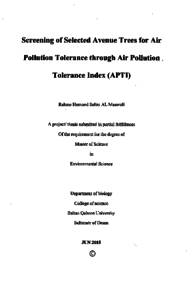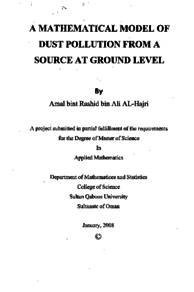Document
Screening of selected avenue trees for air pollution tolerance through air pollution tolerance index (APTI)
Publisher
Sultan Qaboos University
Gregorian
2015
Language
English
Subject
English abstract
Clean air, pure water and food are basic amenities of life but the quality of air, water and land is deteriorating continuously. That is due to the major problem the earth is facing today which are global warming and air pollution. Air pollution resulting from vehicular emissions is more complex than most other environmental challenges. No physical or chemical method is known to ameliorate air pollution resulting from vehicular emissions. A suitable way is to grow green plants and trees along roadsides, Since air pollution tolerance level differs from species to species, thus the determination of Air Pollution Tolerance Index (APTI) and Anticipated Performance Index (API) of the plant species in urban area is important to identify for implementing pollution control methods. Plants with high APTI and API values are more tolerant to air pollution. The identification of the tolerant plant species suggests appropriate species for growing especially in polluted areas. Hence in the present study Air Pollution Tolerance Index (APTI) for 10 avenue tree species has been evaluated by analyzing four important chemical parameters which are total chlorophyll content (TCH), Ascorbic acid (AA), Leaf extract pH and Relative water content (RWC). The studied species are the most common trees which are grown in Sultan Qaboos Street in Muscat, Oman. The Anticipated Performance Index (API) of these plant species was also calculated by considering their APTI values together with other socio-economic and biological parameters. Based on these two indices, among the studied plant species the most suitable one for clean avenue environment was Ficus benghalensis and it be recommended for extensive planting. Conocarpus erectuse, Phoenix dactylifera and Pithcellobium dulce were also judged to be as good performers but their API value were less than Ficus benghalensis. However, Azadirachta indica qualified in the moderate category. Besides these species, the remaining four species were found to be unsuitable as pollution sink because of their lower anticipated performance. Also, the study evaluated the correlation coefficient between four parameters of plants in APTI formula. A close correlation between APTI and AA was evident. A significant correlation was found between APTI and TCH, APTI and pH. In addition, a significant correlation was also found between AA and TCH, RWC and TCH.
Description
Thesis
Member of
Resource URL
Arabic abstract
الهواء النظيف والماء النقي والطعام المغذي تعد أهم العناصر الأساسية للحياة، ولكن جودة الهواء والماء والأرض أصبحت تتدهور بشكل مستمر هذا بسبب المشاكل الرئيسية التي تواجه الأرض اليوم وأهمها ظاهرة الاحتباس الحراري وتلوث الهواء. يعد تلوث الهواء الناتج من عوادم المركبات هو الأكثر تعقيدا من معظم التحديات البيئية الأخرى، حيث لا تعرف أي طريقة فيزيائية أو كيميائية لتحسين تلوث الهواء الناتج من عوادم المركبات. الطريقة المناسبة فقط هي زراعة النباتات الخضراء على جوانب الطرق، وتختلف مستوى مقاومة النباتات التلوث من نبات لآخر لذلك تحديد كلا من مؤشر مقاومة تلوث الهواء (APTI و مؤشر الأداء المتوقع (API) النباتات المزروعة خصوصا في المدن يعد مهما لتطبيق طرق التحكم بالتلوث، والنباتات التي تمتلك قيمة عالية من (APTI) و (API) تعد الأكثر مقاومة وامتصاصا للتلوث الهوائي وتحديدها مهم لاختيار النباتات المناسبة للزراعة خصوصا في المناطق الملوثة. وقد هدفت الدراسة الحالية حساب مؤشر مقاومة تلوث الهواء (APTI) لعشرة أنواع من النباتات وذلك من خلال تحليل أربعة مقاييس كيميائية هامة وهي المحتوى الكلوروفيلي (TCH)، وحمض الأسكوربيك (AA)، والرقم الهيدروجيني(pH) والمحتوى المائي النسبي (RWC ). شملت عينة الدراسة أنواع النباتات الأكثر شيوعا في شارع السلطان قابوس في مسقط بسلطنة عمان. كما تم حساب مؤشر الأداء المتوقع (API) لهذه الأنواع النباتية أيضا من خلال النظر في قيم مؤشر مقاومة تلوث الهواء (APTI) مع مجموعة من المعايير الاقتصادية والأحيائية الأخرى. وبناءا على هذه المؤشرين، من بين أنواع النباتات المدروسة كانت الشجرة الأكثر مناسبة لبيئة شوارع نظيفة وخالية من التلوث هي Ficus benghalensis وتم تقييمها تحت صنف الأداء الجيد. كذلك الأنواع النباتية Pitfucellobiumr dulce , Conocarpus erectuse , Phoenix dactylifera صنفت تحت صنف الأداء الجيد ولكن بمعدل API أقل. كما صنف النبات Azadirachta indica تحت صنف لأداء المتوسط. وإلى جانب هذه الأنواع تم تصنيف الأنواع الأربعة المتبقية لتكون غير مناسبة لامتصاص التلوث. كذلك حسبت الدراسة معامل الارتباط بين المعايير الكيميائية الأربعة و APTI في النباتات، ووجدت أن هناك ارتباط طردي قوي بين APTI و AA ، كما وجدت ارتباط طردي متوسط بين AA و RWC، TCH و APTI ،TCH و TCH ، APTI و pH
Category
Theses and Dissertations


